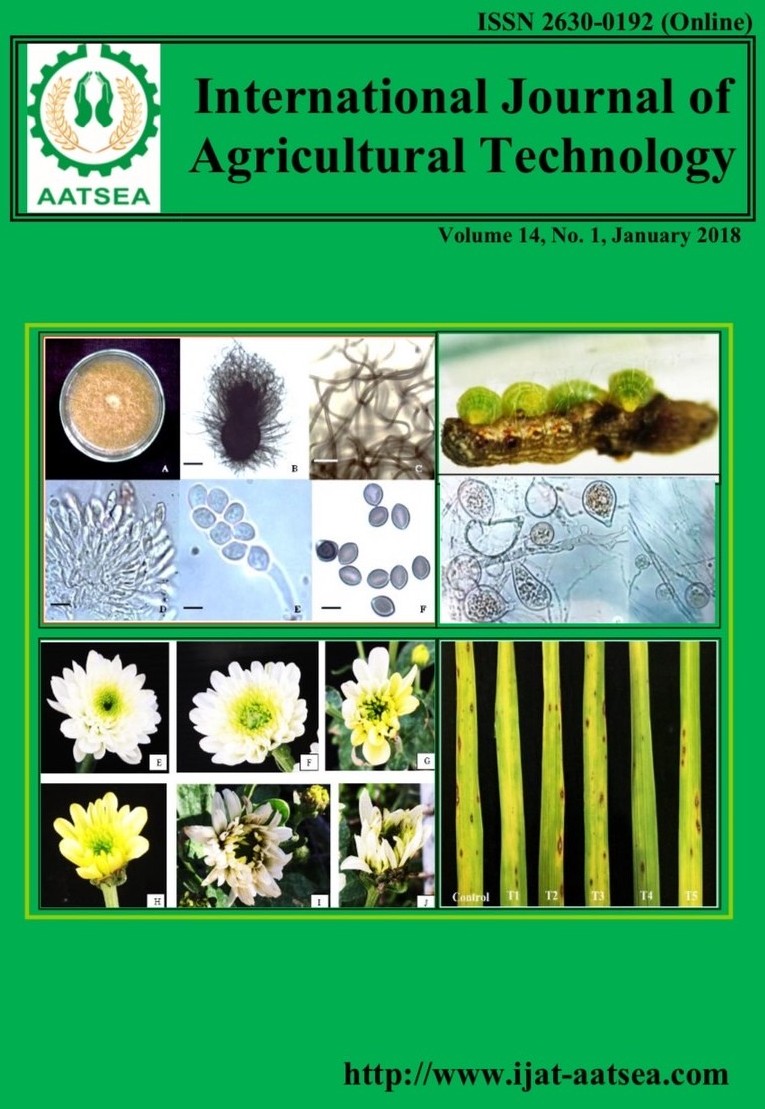Method Development for Pesticide Determination in Paddy Rice Using Near Infrared Spectroscopy
Main Article Content
Abstract
A growing world population leads to an increase in demand for agricultural products and food. In order to increase crop yield, pesticides have been extremely used, resulting in a high risk to environment and human health. A large number of pesticides are used on paddy rice field in Southeast Asia countries. Carbofuran is a highly toxic insecticide to vertebrates that has been illegally used on paddy field and other crops in developing country with a poor application and management. In order to maintain public health condition, the control and determination of pesticide residues in agricultural products is extremely needed. This study aimed to investigate the feasibility of near infrared (NIR) spectroscopy for a rapid determination of carbofuran in paddy rice. Thai jasmine paddy rice artificially contaminated with carbofuran ranging from 0-50 ppm was used as samples. The NIR measurements of the paddy rice were performed using reflectance FT-NIR spectroscopy as a nondestructive determination. The attempt to improve prediction efficiency of carbofuran residue was then performed using the dry-extract system for (near) infrared (DESIR) technique. The reflectance NIR spectra of DESIR samples were also obtained. For data analysis, partial least square (PLS) regression was used to develop a calibration model for the carbofuran prediction. It was found that the spectra of the contaminated paddy rice provided insufficiently accurate calibration results with coefficient of determination (R2) of 0.87 and root mean square error of prediction (RMSEP) of 7.20 ppm. Superior prediction accuracy was obtained from the calibration model based on the spectra of DESIR samples (R2 = 0.99, RMSEP = 3.05 ppm). It was concluded that NIR spectroscopy combined with DESIR technique had a potential to be a rapid and effective method for the determination of carbofuran in paddy rice. This method could become a powerful tool for coping with the environmental and health risk caused by a misuse or overuse of pesticides.
Article Details

This work is licensed under a Creative Commons Attribution-NonCommercial-NoDerivatives 4.0 International License.
References
Acharya, U. K., Subedi, P. P. and Walsh, K. B. (2012). Evaluation of a Dry Extract System Involving NIR Spectroscopy (DESIR) for Rapid Assessment of Pesticide Contamination of Fruit Surfaces. American Journal of Analytical Chemistry 3:524-533.
Bagchi, T. B., Sharma, S. and Chattopadhyay, K. (2016). Development of NIRS models to predict protein and amylose content of brown rice and proximate compositions of rice bran. Food Chemistry 191:21-27.
Huertas-Pérez, J. F., Gámiz-Gracia, L., García-Campãna, A. M., Gonźalez-Casado, A. and Vidal, J. L. M. (2005). Chemiluminescence determination of carbofuran at trace levels in lettuce and waters by flow-injection analysis. Talanta 65:980-985.
Kesemsumran, S., Thanapase, W. and Kiatsoonthon, A. (2007). Feasibility of near-infrared spectroscopy to detect and to quantify adulterants in cow milk. Analytical Sciences 23: 907-910.
Martin D. P. and Shepherd D. N. (2009). Review: The epidemiology, economic impact and control of maize streak disease. Food Security 1:305-315.
Nicoli, B. M., Beullens, K., Bobelyn, E., Peirs, A., Saeys, W., Theron, K. I. and Lammertyn, J. (2007). Nondestructive measurement of fruit and vegetable quality by means of NIR spectroscopy: A review. Postharvest Biology and Technology 46:99-118.
Numthuam, S., Hongpathong, J., Charoensook, R. and Rungchang, S. (2017). Method development for the analysis of total bacterial count in raw milk using near-infrared spectroscopy. Journal of Food Safety 37:e12335.
Osborne, B. G., Fearn, T. and Hindle, P. H. (1993). Practical NIR Spectroscopy with Application on Food and Beverage Analysis. Longman Scientific and Technical. 217 pp.
Otieno P. O., Lalah J. O., Virani M., Jondiko I. O. and Schramm K. W. (2010). Soil and water contamination with carbofuran residues in agricultural farmlands in Kenya following the application of the technical formulation Furadan. Journal of Environmental Sciences and Health 45:137–144.
Ramesh, M., Narmadha, S. and Poopal, R. K. (2015). Toxicity of furadan (carbofuran 3%g) in Cyprinus carpio: Haematological, biochemical and enzymological alterations and recovery response. Beni-Suef University Journal Basic Applied Sciences 4:314–326.
Saranwong, S. and Kawano, S. (2005). Rapid determination of fungicide contaminated on tomato surfaces using the DESIR-NIR: a system for ppm-order concentration. Journal of Near Infrared Spectroscopy 13:169-175.
Tennakoon, D. A. S. S., Karunarathna, W. D. V. and Udugampala, U. S. S. (2013). Carbofuran concentrations in blood, bile and tissues in fatal cases of homicide and suicide. Forensic Science International 227:106-110.
Tsenkova, R., Atanassova, S., Kawano, S. and Toyoda, K. (2001). Somatic cell count determination in cow’s milk by near-infrared spectroscopy: a new diagnostic tool. Journal of Animal Science 79:2550–2557.
Williams, P. and Norris, K. (2001). Near-Infrared Technology in the Agricultural and Food Industries, 2nd ed., American Association of Cereal Chemists, USA.
Zan, K. L. and Chantara, S. (2007). Optimization Method for Determination of Carbofuran and Carboxin Residues in Cabbages by SPE and HPLC-UV. Chiang Mai Journal of Sciences 34:227-234.


